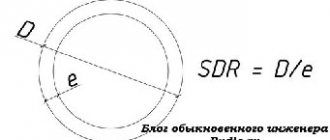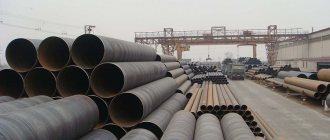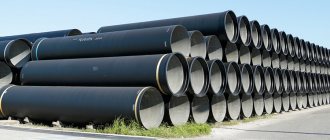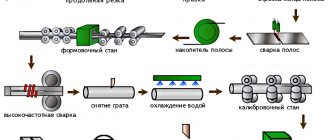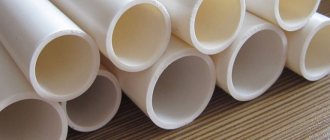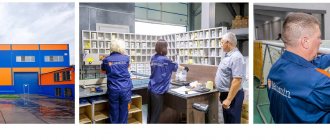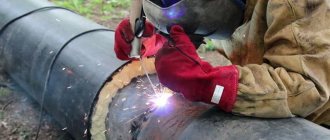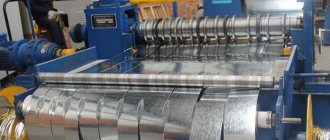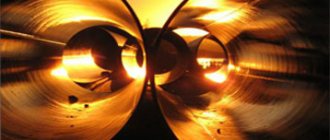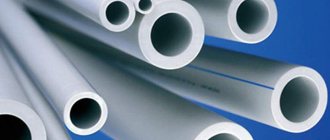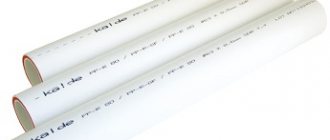To consider the topic of manufacturing polypropylene pipes and fittings for water supply and heating pipelines, it is necessary to first provide detailed characteristics of the materials used for production.
Polypropylene pipes and fittings have a large number of advantages that distinguish them from their steel counterparts:
- they are much lighter;
- are not affected by corrosion;
- do not overgrow inside during use;
- do not create vibration and rumbling, as well as other noise;
- do not burst when the water in the system freezes;
- do not conduct electrical charge;
- do not need painting;
- very easy to use.
Pipes and fittings made of polypropylene can last for decades. These are environmentally friendly products that are successfully used for pipelines of any level of complexity. Therefore, their production and manufacturing is widely established all over the world.
The use of fittings with chrome and brass inserts allows you to combine these blanks with steel pipes.
The design of these materials is very tight, and this application brings tangible economic benefits.
A little about polypropylene
Polypropylene is the starting product of the polymerization of propylene and ethylene in specific quantities. The resulting material is called PPRC random copolymer.
In the domestic market today there is no worthy analogue to foreign polymers. For the production of polypropylene pipes, we use the Finnish RA 130E BOREALIS and the Hungarian TIPPLEN CS4-8000 TVK.
The essence of the pipe manufacturing process is simple, and it is not very labor-intensive. Speaking about it, we need to highlight the following features:
- low energy costs during production;
- environmental friendliness;
- for the production, installation and use of one set of lines for the production of polypropylene pipes and fittings, you do not need a lot of space (this is approximately 100 m2);
A complete polypropylene pipe extrusion line is a complete cycle of extrusion, calibration, cooling, exhaust, etc.
Organizational aspects
To begin production of the products in question, it is necessary to select a good premises for production. Its area must be at least fifty square meters. In such an area you can compactly place the necessary equipment.
It is important that the air temperature in such a workshop is not lower than eighteen degrees. Equipment for the production of sandwich pipes will largely coincide with that used for the production of air ducts and ventilation ducts.
Welding machine
To open a business you must have:
- welding machine;
- folding machine;
- mobile walk-through sheet bender;
- folding machine;
- equipment for rolling stiffeners;
- machine for cutting rolled metal.
Smoke exhaust ducts are joined using corrugated elbows. Therefore, it is wise to purchase equipment to make these fittings.
This machine comes in two types: semi-automatic and automatic. In the first case, your employee will have to manually reinstall the workpiece and restart the equipment.
Types of equipment for manufacturing
Equipment for the production of polypropylene pipes (exruders) are machines of the following types:
- Screw. They function similar to a juicer or meat grinder.
- Screwless. They are used to produce blanks from mixed materials. The main part in these mechanisms is the disk.
- Combined. In these mechanisms, the screw part is combined with a disk.
IMPORTANT! The screw type of machine is considered the most common equipment for the production of plastic products.
In addition to the extruder, lines for the production of plastic pipes also have the following equipment:
- Raw material supply system.
- A machine that cuts blanks.
- Container for calibrations and cooling.
- Pulling mechanism.
- Mixer.
- Conveying tape.
- Vacuum forming.
- An accumulating mechanism that stacks workpieces.
Electromechanical or manual folding machines
The seam-setting machine is designed for seam-setting in the production of hollow cylindrical parts of air ducts. The devices are both manual and electric. For the longevity of this equipment, it is important that the pressing rollers in the unit are made of hardened steel. Electromechanical models usually provide a clamp level adjustment system.
It is possible to carry out high-quality upsetting of seams only with the help of a machine
Folding machines are presented in a wide range of models. The differences between them will be:
- type of drive for moving the forming roller (manual, electric);
- installation method: fastening to the floor or wall;
- length of the folded seam;
- performance;
- price.
For machines with the same rebate lock length, the performance is practically the same. Using this machine, it is possible to process about 50 parts per working hour.
Selection of raw materials
When choosing raw materials, the choice is granular polymer, but you need to carefully look at its shelf life.
But polypropylene and polyethylene are practically not limited by these indicators, which makes it more convenient to use.
From an economical point of view, copolymer and HDPE are beneficial.
IMPORTANT! When opening your own production for the manufacture of polypropylene pipes and fittings, it is advised to maintain cooperation with one supplier. Because changing raw materials requires changing equipment for producing polypropylene products.
Manufacturing process
The main equipment that processes raw materials and turns it into a polypropylene pipe or fitting is called an extruder. And the manufacturing itself takes place in the following sequence:
- Raw materials for the manufacture of pipes and fittings are fed into a special chamber. It is small granules or comes in the form of chips. Secondary raw materials that have undergone pre-processing (grinding) are also often used. Secondary raw materials are mixed with primary ones.
- Using electric or gas heating, the poured mass is melted. Temperature readings range from 230 to 250 degrees. But it does not turn into liquid, but only becomes viscous. To prevent this viscous heated mass from sticking to the walls of the apparatus, they are coated with Teflon.
- Next, the extruder squeezes out the blanks from the thick mixture according to the set size. Typically the length of the workpiece is two and a half meters. The equipment performs all these actions very quickly and completely autonomously. Human intervention is only required to set the required parameters for operation. The best equipment for the production of polypropylene pipes and fittings is capable of producing up to 200 kg of products per hour of operation.
- The next stage is cooling of the workpieces. To do this, they are placed in a container for cooling. The cooling process takes place in a couple of minutes. Then it perfectly maintains the specified dimensions. In the cooling container, the plastic is subject to a forming process; during the process, the material is thoroughly rounded and takes on the desired shape.
- At the end of the production process, markings are applied to the products, which display the operating parameters of the products; the batch number and the date of production of the product are indicated here. Then the blanks are packaged, packaged and sent to warehouses or to consumers.
Video
Extrusion line for the production of pipes, hoses and other products from PVC and LDPE
In addition to the main products (pipes), it is necessary to produce components. They are often produced in the same factories as pipes.
Only for the production of polypropylene fittings it is necessary to install additional equipment (machine).
It does not take up a large amount of space, but it makes it possible to increase the range of products. This becomes an important factor for companies, especially in highly competitive conditions.
Mobile sheet bending machine for the production of stainless steel products
The choice of sheet bending machine will be based on the following principles:
1. The equipment must have a power reserve. To ensure that the machine does not quickly become unusable, and unexpected failures do not occur during the production process, the equipment must be able to process metal sheets that are 30-50% thicker than expected.
For small production volumes, you can use a manual sheet bender
2. Budget for the purchase of the unit. The cost of the equipment will depend on the category of sheet bending machine. These devices are divided into three large groups:
- manual sheet benders;
- electromechanical;
- hydraulic.
The category of manual sheet benders includes all equipment that does not have a mechanical drive. In turn, manual ones have several more subgroups: they are stationary and mobile. For chimneys and air ducts, walk-through mobile sheet benders with manual controls are suitable. Some manual pipe benders have cutting knives that allow the machine to perform two functions: bending and cutting metal.
Hydraulic and electromechanical machines have a significantly higher cost, but only with their help can large-scale production be established. The simplest equipment in this category is suitable for thin-walled products (up to 1.5 mm, with a minimum thickness of chimneys of 1 mm), and machines with powerful hydraulics can process sheet metal with a thickness of up to 20 mm. Electrically and hydraulically driven equipment is sometimes equipped with a set of CNC programs. For small enterprises, the cost of such machines will be too high (from 18,000 USD), and more qualified personnel will have to be hired to work with mechanical equipment.
For those who are looking for the most budget-friendly option for the manufacture of chimneys or other types of pipes, it is worth paying attention to sheet bending machines made in Russia or China.
Important Details
Basalt or stone wool should be used as insulation. Use quality material if you want your products to have a good reputation. The fastening of two pipes of different diameters must be reliable. It is not enough to insert one element into another and fill the space between them with insulation.
Product Installation
Also, to produce sandwich pipes for chimneys, you need to use special software to design the products. If the workshop is well equipped and the work process is properly organized, then up to 500 finished products can be produced in one work shift.
Watch the video:
Areas of use of different types of pipes
Until recently, various metals were used as materials for pipes. Steel, cast iron, copper and other products were widely used in communications and other areas. However, with the development of industrial technologies, products made from various polymer compounds began to appear, which led to great changes in this market segment.
Plastic pipes have a number of undeniable advantages over their metal counterparts: the production and cost of such products are cheaper, have high anti-corrosion properties and have a long service life. They are easy to transport and install and have an aesthetic appearance.
However, the use of plastic pipes is not always possible due to certain circumstances. As an example, the use of products made of polymer materials for utility gas pipelines is strictly prohibited. This is due to the fact that the structure transporting gas must have high strength characteristics. Therefore, indoor gas pipelines are installed only from metal pipes.
For the installation of pipelines operating in extreme conditions, only pipes made of steel can be used
Note! In all cases where high communication strength is required, metal parts are used. This is due to the fact that, despite all its advantages, plastic products cannot boast of very high strength. The manufacture of pipelines that require certain technical characteristics according to GOST from such products is prohibited.
Depending on the purpose, the main operational areas of these products can be distinguished:
- Various media are transported through pipes. The physical state of the medium can be liquid or gaseous;
- use as a protective casing for various communications. They are most often used to protect cables and various wiring;
- use as supports for main pipelines;
- for drilling and strengthening wells;
- for water pipelines (household and technical);
- for gas pipelines;
- for sewer communications;
- for chimney structures;
- for ventilation systems.
We can list only the most common ways of using various pipes. However, these are not all the areas in which communications from these products are used.
Rolling of stiffeners
To strengthen the design of products, you need to use special machines to create stiffeners. The process is carried out by bending the walls of the seal in increments of about twenty centimeters.
Such equipment includes two components that guarantee an even profile: a forming device and a welded bed. The first part most often looks like rollers with rollers.
The creation of stiffeners occurs simultaneously along the entire length. The key feature of this equipment is that the workpiece being processed is not subject to deformation.
